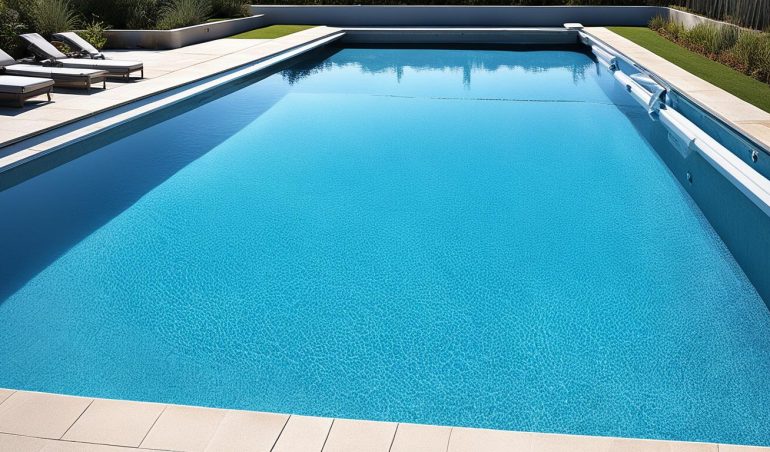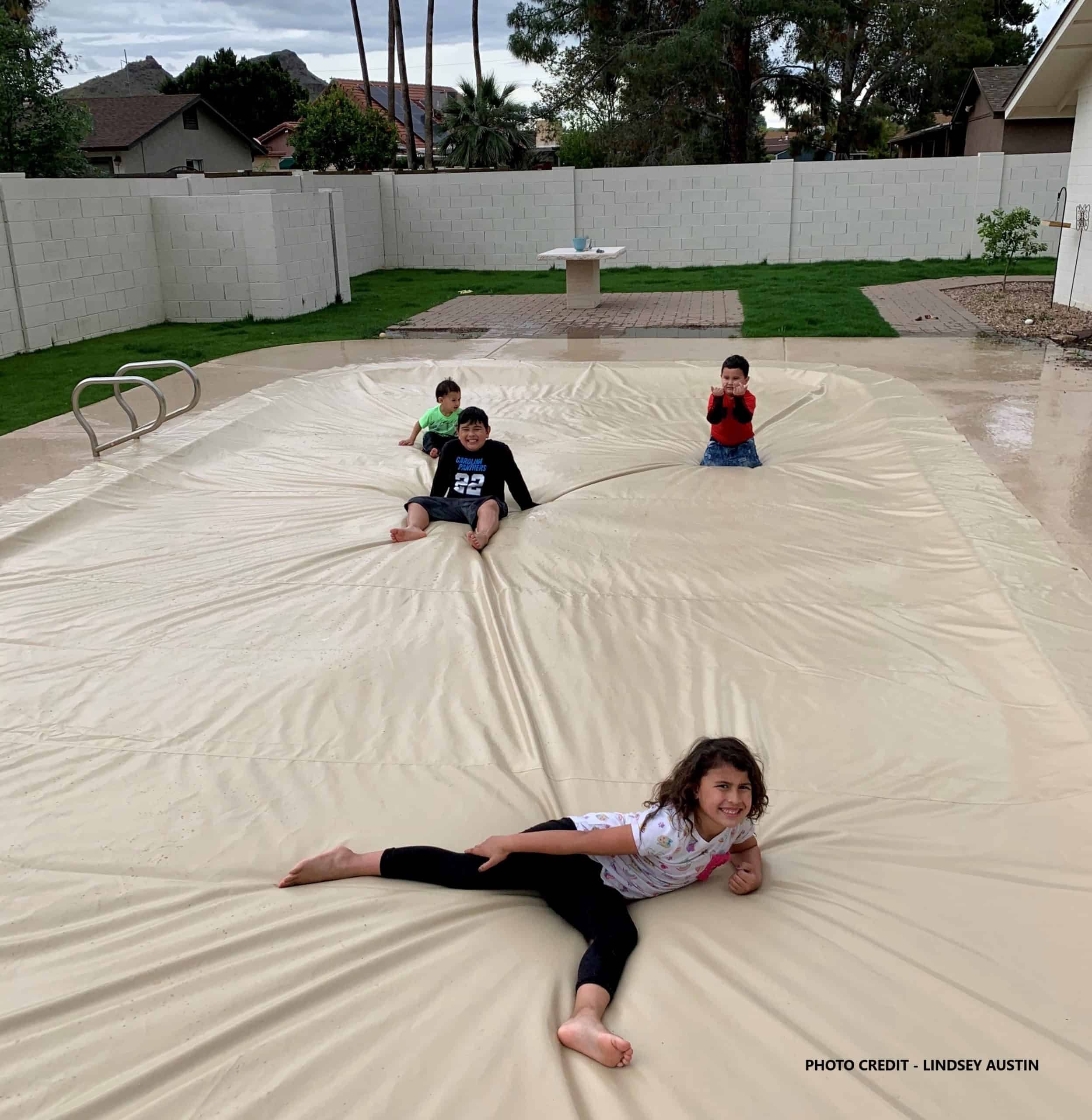Imagine this: it’s a beautiful summer day, the sun is shining, and you can’t wait to take a refreshing dip in your pool. But as you approach the water, you can’t help but feel a wave of disappointment. The pool is ice-cold, and it looks like another day of waiting for it to warm up. Does this scenario sound familiar? If so, you’re not alone.
Many pool owners have experienced the frustration of a pool that takes forever to heat up. But what if there was a solution? What if there was a way to make your pool warm and inviting, even on those cooler days? Well, that’s where thermal pool covers come in.
Thermal pool covers are specially designed to help retain heat in swimming pools. They minimize evaporation, which is the largest source of energy loss in pools, and help regulate pool temperature. But do they actually work? Can they make a noticeable difference in the warmth of your pool? Let’s find out!
Key Takeaways:
- Thermal pool covers are designed to retain heat and reduce energy costs in swimming pools.
- They minimize evaporation, the largest source of energy loss in pools, and help regulate pool temperature.
- Many studies have shown that thermal pool covers can significantly save energy and reduce heating costs.
- The effectiveness of thermal pool covers varies depending on factors such as climate, pool size, and cover type.
- Choosing the right type of pool cover and using it strategically can maximize its benefits and optimize energy efficiency.
Understanding Thermal Pool Cover Effectiveness
Thermal pool covers play a crucial role in reducing energy loss and maximizing pool efficiency. To comprehend their effectiveness, it is essential to explore their impact on energy savings, heating costs, and the delicate balance between evaporation and solar gain.
Energy Savings from Reduced Evaporation
Thermal pool covers are highly effective in curbing energy loss caused by evaporation. By covering the pool surface, these covers act as a barrier that prevents water from evaporating. This simple yet effective measure significantly reduces the amount of heat lost, resulting in substantial energy savings. The specific energy savings achieved can vary depending on factors such as the climate, pool size, and type of cover used.
Impact on Heating Costs in Various US Cities
Studies have demonstrated the significant impact of thermal pool covers on heating costs. It has been found that pool owners who diligently cover their pools with thermal covers can save 50% to 70% on their heating expenses. The actual savings depend on factors like the local climate and the cost of energy in different US cities. Regardless of the location, thermal pool covers have proven to be a cost-effective investment for reducing heating costs in various regions.
The Balance Between Evaporation and Solar Gain
One critical aspect of thermal pool cover effectiveness is the delicate balance between evaporation and solar gain. Thermal covers not only prevent evaporation but also harness solar energy to heat the pool naturally. Striking the right balance ensures optimal energy conservation and pool temperature regulation. By minimizing evaporation while promoting solar gain, thermal pool covers maximize their performance and efficiency.
To visually illustrate the performance of thermal pool covers, the image above showcases the mechanisms by which they prevent evaporation and retain heat, leading to energy savings and efficient pool operation.
The Science Behind Thermal Pool Covers
Thermal pool covers are not just a simple accessory for your pool; they are backed by science and designed to provide numerous benefits. Understanding the science behind these covers can help pool owners make informed decisions and fully utilize their advantages.
How Evaporation Affects Pool Temperature
Evaporation plays a crucial role in pool temperature regulation. When water evaporates from the pool surface, it takes a significant amount of heat with it, causing the pool water to cool down. This can lead to increased energy consumption as more heat is needed to maintain the desired temperature.
Why Covering Your Pool Saves Energy
Thermal pool covers offer a solution to the problem of evaporative heat loss. By covering the pool surface, these covers create a barrier that minimizes evaporation. This helps to retain heat within the pool, reducing the energy required to maintain the desired temperature. The result is notable energy savings and lower heating costs for pool owners.
Comparison of Indoor and Outdoor Pool Energy Conservation
Both indoor and outdoor pools can benefit from thermal pool covers, although the energy conservation needs may vary. Indoor pools require effective ventilation systems to control the humidity caused by evaporation. On the other hand, outdoor pools face additional challenges such as wind and fluctuating external temperature, which can accelerate evaporation rates. Thermal pool covers help mitigate these challenges and provide energy-saving advantages for both types of pools.
Comparing Types of Pool Covers
When it comes to pool covers, there are various options available to suit different needs and preferences. Understanding the features and benefits of each type can help you make an informed decision. In this section, we will compare bubble covers, vinyl covers, and insulated pool covers, as well as explore different operation options.
Bubble Covers Versus Vinyl Covers
Bubble covers and vinyl covers are two popular choices for pool owners. Bubble covers, also known as solar covers, are made of a thicker grade of plastic with added UV inhibitors. They are designed to reduce evaporation and can also absorb solar energy, helping to heat the pool water. These covers are cost-effective and can provide thermal insulation.
On the other hand, vinyl covers are generally heavier and offer a longer lifespan compared to bubble covers. They are available in different colors, allowing you to choose one that matches your pool aesthetics. Vinyl covers provide better insulation and can effectively minimize evaporation, resulting in reduced heat loss.
Advantages of Insulated Pool Covers
Insulated pool covers offer superior heat retention and energy-saving benefits. They consist of a layer of flexible insulation sandwiched between two layers of vinyl. This insulation layer helps to trap and retain heat, making it an ideal choice for pool owners who want to minimize heat loss and reduce heating costs. Insulated covers provide excellent thermal efficiency and can maintain the pool temperature for a longer period.
Automatic, Semi-Automatic, and Manual Pool Cover Options
Pool covers are available in different operation options to cater to various user preferences. Manual covers require manual handling and can be more labor-intensive. They are typically more affordable but may require more effort to operate.
Semi-automatic covers typically feature a reel system that assists with cover deployment and retraction. These covers provide a good balance between convenience and cost-effectiveness.
Automatic covers are the most convenient option, as they can be operated with the push of a button. They offer a high level of automation, making it easy to cover and uncover the pool. However, automatic covers tend to be more expensive compared to manual and semi-automatic options.
When choosing a pool cover, consider factors such as your budget, pool size, and desired level of automation. A thermal pool cover review can also help you determine which cover type best suits your needs and preferences.
Optimal Utilization of Thermal Pool Covers for Maximum Benefits
To maximize the benefits of thermal pool covers and ensure their effectiveness, it is crucial to use them strategically and follow proper usage guidelines. By adopting the appropriate practices, pool owners can maximize energy savings and extend the lifespan of their pool covers.
When to Remove and Replace Covers for Daily Swimmers
For pools that are regularly used by swimmers on a daily basis, it is recommended to remove the thermal pool cover before swimming and replace it immediately after use. This allows swimmers to enjoy the full benefits of the pool while minimizing any potential damage or wear and tear to the cover. Removing the cover before swimming also ensures the safety of swimmers by eliminating the risk of entanglement or accidental entrapment.
Adjusting Cover Usage Based on Climate Conditions
The usage of thermal pool covers should be adjusted based on the prevailing climate conditions. Factors such as wind and temperature fluctuations can impact the rate of evaporation, which directly influences the pool’s heat retention and energy efficiency. In areas with higher wind speeds or cooler temperatures, it is advisable to keep the cover on for longer periods to minimize heat loss. Conversely, in warmer climates, the cover can be used more selectively to allow for solar gain during the day while still preventing excessive evaporation.
By monitoring the weather conditions and adjusting cover usage accordingly, pool owners can optimize the benefits and performance of their thermal pool covers, leading to increased energy savings. Regular inspection and maintenance of the cover are also essential to ensure its proper functioning and durability. This includes checking for any signs of wear, tear, or damage, and addressing them promptly to prevent further issues.
Wrapping up with our Solar Safe Pool Covers Experts
Thermal pool covers have proven to be highly effective in reducing energy loss and heating costs for swimming pool owners. By minimizing evaporation, these covers help retain heat in the pool, resulting in significant energy savings. Numerous studies have demonstrated the positive impact of thermal pool covers on reducing heating costs and energy consumption.
The choice of pool cover type will depend on various factors such as budget, climate, and desired level of insulation. Bubble covers, vinyl covers, and insulated covers each offer unique advantages and levels of heat retention. Pool owners can select the cover that best aligns with their specific needs and preferences.
To optimize the effectiveness of thermal pool covers, proper usage and maintenance is essential. Pool owners should remove the cover before swimming and promptly replace it afterward when the pool is regularly used. Additionally, adjusting cover usage based on climate conditions, such as wind and temperature fluctuations, can further enhance its performance.
In conclusion, thermal pool covers are a worthwhile investment for pool owners seeking energy efficiency and cost savings. By minimizing evaporation and retaining heat, these covers effectively reduce energy loss and heating costs. With the right cover type and proper usage, pool owners can maximize the benefits of thermal pool covers and enjoy a more environmentally friendly and cost-effective pool heating solution.
If you are a pool owner in the Arizona area we service Phoenix and Tucson metro and can provide a free quote and estimate on a thermal pool cover for you. Contact us today for a quote.
FAQ
Do thermal pool covers work?
Yes, thermal pool covers are effective in reducing energy loss and heating costs. They work by minimizing evaporation, which is the largest source of energy loss in pools.
What are the energy savings from reduced evaporation?
Studies have shown that covering a pool with a thermal cover can save 50% to 70% in heating costs. The actual savings depend on factors such as climate, pool size, and cover type.
How does evaporation affect pool temperature?
Evaporation requires a large amount of energy and leads to a substantial loss of heat. By covering the pool, thermal pool covers minimize evaporation and help retain heat, reducing the energy needed to heat the pool.
What are the advantages of insulated pool covers?
Insulated pool covers have a layer of flexible insulation sandwiched between two layers of vinyl. They offer superior heat retention and can reduce heat loss significantly compared to other types of covers.
What are the options for pool cover operation?
Pool covers can be manual, semi-automatic, or automatic. The choice depends on factors such as budget, pool size, and desired level of automation.
When should I remove and replace the pool cover for daily swimmers?
If the pool is regularly used, the cover should be removed before swimming and replaced immediately after use to maximize the benefits of thermal pool covers.
How should cover usage be adjusted based on climate conditions?
Wind and temperature fluctuations can affect evaporation rates. Adjust the usage of the cover accordingly to minimize heat loss through evaporation.






